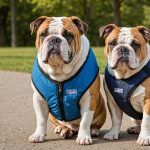Understanding the Importance of Hind Leg Strength in German Shepherds
The hind leg strength of German Shepherds plays a crucial role in their overall performance and mobility. As active and energetic dogs, they rely on strong hind legs to support their dynamic activities, including running, jumping, and playful interactions. Hind leg strength is not only vital for agility but is also a key factor in preventing injuries that could affect long-term canine health. Without it, these dogs might struggle with daily activities, and experience a diminished quality of life.
German Shepherds with weak hind legs commonly face issues such as difficulty in standing, moving, and even severe pain. Over time, this can lead to further complications, including arthritis and hip dysplasia, which are prevalent in the breed. Recognising and addressing these issues early on is essential for maintaining their mobility and overall wellness.
In parallel : Top Cooling Vests to Keep Your English Bulldog Comfortable and Cool on Hot Days
On the other hand, maintaining strong hind legs can contribute significantly to a German Shepherd’s health and longevity. Benefits include improved balance, reduced risk of falls, and the ability to maintain an active lifestyle well into their senior years. Consistent exercise, a balanced diet, and regular veterinary check-ups are crucial in ensuring that a German Shepherd’s hind legs remain strong and healthy throughout its life.
Effective Exercises for Boosting Hind Leg Strength
Incorporating effective workouts is crucial to enhance your furry friend’s hind leg strength through dog exercises. Here’s how you can employ fitness routines to achieve this.
Topic to read : Understanding the Health Risks of Overfeeding Your Toy Fox Terrier and Tips for Prevention
Resistance Band Training
Resistance bands are great for strength training for dogs as they target specific hind leg muscles. Start by securing a band around your dog’s ankles and gently guide them to walk forward. This added resistance encourages muscle growth while remaining a low-impact option. Remember, patience is key. Gradually increase the tension as your pet becomes accustomed to the exercise.
Squats and Lunges
Squats and lunges, not just for humans, can aid in strengthening dog legs. Guide your dog to sit and stand repetitively, resembling a squat. Similarly, lead them into forward-step lunges, ensuring they maintain a straight posture. These dog exercises are perfect for activating hind muscle groupings effectively.
Stair Climbing
Incorporate stair climbing into your dog’s fitness routines as this naturally builds strength. Encourage your pet to climb stairs at a steady pace, ensuring safety and support throughout. Begin with short sessions, increasing duration as your dog becomes more comfortable.
For optimal results, aim for these exercises two to three times a week, allowing rest days in-between. Always prioritize your dog’s comfort and safety, adapting exercises as needed.
Nutritional Support for Muscle Development
Enhancing a German Shepherd’s muscle growth involves prioritising dog nutrition. Essential nutrients such as protein, omega fatty acids, and carbohydrates are pivotal in building and maintaining muscle mass. Proteins, in particular, serve as building blocks for muscular strength, vital in a canine diet. Protein-rich sources like lean meats, fish, and eggs can be excellent additions to a German Shepherd’s meal plan.
To complement meals, canine diet supplements like glucosamine and chondroitin are beneficial. These not only support muscle development but also aid in joint health, crucial for active breeds. Supplements formulated with amino acids can further enhance their muscle-building potential, contributing to a well-rounded canine diet.
Alongside nutrition, hydration plays a crucial role in muscle recovery and performance. Ensuring your German Shepherd remains hydrated optimises their fitness regimen. Water aids in digestion, nutrient absorption, and temperature regulation, helping maintain stamina during physical activities.
Furthermore, remember the significance of recovery periods. During rest, muscles repair and grow, necessitating a balance of nutrients and downtime in their routine. Combining a nutrient-rich diet with strategic exercise and rest periods fosters robust muscle development and overall health in German Shepherds.
Health Considerations and Veterinary Advice
Understanding canine health care is essential for the well-being of our furry friends. Early recognition of issues and adherence to professional veterinary recommendations can prevent potential health problems.
Recognizing Signs of Weakness or Injury
Identifying symptoms of weakness or injury in dogs can significantly influence their recovery. These signs may include difficulty in movement, reluctance to engage in play, or unusual crying out during activities. Observing these alerts is vital for timely intervention.
Importance of Regular Vet Check-ups
Ensuring regular veterinary visits is indispensable to effective dog injury prevention. Routine check-ups can help detect underlying conditions often invisible to the naked eye. Veterinary recommendations during these visits can provide insights on necessary lifestyle adjustments and diet changes that cater specifically to your dog’s needs, promoting long-term health and vitality.
Advanced Relaxation and Recovery Techniques
Incorporating advanced relaxation and recovery methods into your dog’s exercise routine can foster quicker recuperation. Techniques such as hydrotherapy, massage, or canine physiotherapy are especially beneficial. These approaches not only aid in recovery but can also be preventive measures against future injuries, acting as a holistic addition to canine health care practices.
Visual and Practical Resources for Owners
Navigating the journey of effective dog training requires reliable resources. For visual learners, instructional videos offer invaluable support. These videos break down complex training tasks into manageable steps with clear demonstrations. Platforms like YouTube and specialized streaming services host a wealth of video guides featuring expert trainers. Such resources help owners understand nuances of posture, timing, and intonation crucial in commands.
In addition to videos, resources for tracking progress are vital. Mobile applications and online tools serve as digital journals, enabling owners to log training milestones and monitor improvements. Such platforms often include goal-setting features, encouraging a consistent and results-driven approach to fitness for your furry friend. These exercise demonstrations apps ensure personalized fitness regimes to suit various breeds and individual temperaments.
Community support amplifies the learning curve. Many online forums and local groups foster environments where dog owners can share insights, seek advice, and celebrate successes. Engaging with these communities provides emotional support and practical advice from fellow enthusiasts. As a result, these dog training resources become more meaningful, creating a collective of owners dedicated to raising well-trained and healthy dogs.
Building a Long-term Fitness Plan
Designing a tailored fitness plan for your German Shepherd is crucial in promoting long-term health. A well-structured plan accommodates the breed’s unique needs, ensuring they receive optimal exercise for their physical capacity.
Structuring the Plan
A training schedule should balance endurance activities and leisure time. Consider incorporating varying exercise types:
- Daily brisk walks
- Short, engaging play sessions
- Weekly agility or obedience training
This holistic approach ensures your dog remains fit, mentally stimulated, and content.
Adjustments Over Time
As German Shepherds age, their physical capacity may change. Adjustments are key to maintain engagement and avoid overexertion. For senior dogs, swap high-intensity activities for gentler exercise like swimming, which is joint-friendly yet maintains strength. Regular veterinary check-ups can provide insights on necessary modifications.
Encouraging Consistency
Consistent engagement in physical activities supports their ongoing strength development. Set manageable goals and integrate activities your dog enjoys. Use positive reinforcement to encourage participation, making exercise a fun routine rather than a chore. By prioritizing dog fitness plans tailored to your pet’s needs, you foster a healthy lifestyle that can promote longevity.
Importance of Hind Leg Strength in German Shepherds
Strong hind legs play a crucial role in the health and mobility of German Shepherds. They contribute to stability and balance, which are vital for these active dogs, known for their agility and strength. The hind leg strength significantly affects their ability to run, jump, and engage in various physical activities—essential components of their daily life and work.
Mobility and Performance
When a German Shepherd possesses robust hind leg strength, it supports better overall mobility. This strength is essential for high-performance activities seen in sports, such as agility courses, and diverse working roles, including search and rescue, police/security duties, and herding. These activities demand extensive hind leg power to ensure swift, precise movements.
Injury Prevention and Aging Support
Strong hind legs are paramount in preventing injuries. They help absorb the impact of jumps and sudden movements, reducing strain on the joints and muscles. As German Shepherds age, maintaining this strength aids in supporting their health by preserving mobility and minimizing discomfort from age-related issues, such as arthritis. Engaging in specific exercises that bolster the hind leg strength can prolong an active, healthy life for these beloved canines.
Effective Exercises to Boost Hind Leg Strength
Focusing on your dog’s hind leg strength can significantly improve their overall fitness and agility. Exercises for dogs should be tailored to their individual needs and abilities for optimal results.
Resistance Training Techniques
Resistance bands can be a valuable tool in strength training. Designed for both humans and animals, these bands add tension, helping dogs build muscle. Incorporating resistance exercises can enhance the development of their hind leg muscles.
- Band Squats: Encourage your dog to perform squats by gently using a resistance band around the hindquarters. This strengthens the muscles while improving stability.
- Backward Walks: Attach a light band and encourage backward walking to enhance hind leg coordination.
Safety is crucial. Ensure the band is securely fastened and monitor your dog’s form to prevent strain. Gradually increase intensity and avoid overworking young or senior dogs.
Functional Exercises
Functional exercises mimic natural movements. Squats benefit hind leg development by engaging muscles needed for sitting and standing. Step-ups, where your dog steps onto a low platform, are excellent for building leg strength and stability.
- Balance Drills: Using a balancing disc or board encourages coordination, improving both strength and agility.
Be patient and praise your dog’s efforts; positive reinforcement is vital for success.
Nutritional Strategies for Supporting Leg Strength
Navigating the world of dog nutrition can greatly enhance your pet’s leg strength across their lifespan. Key nutrients such as protein, omega-3 fatty acids, and antioxidants play a vital role in supporting muscle health and facilitating recovery post-exercise.
For an active dog, a diet for active dogs rich in these nutrients helps maintain optimum muscle function. Protein is essential as it serves as the fundamental building block of muscle, supporting both growth and repair. Meanwhile, omega-3 fatty acids, commonly found in fish oil, are known for their anti-inflammatory properties, which can alleviate joint stress often experienced by active canines. Antioxidants help combat oxidative stress, fortifying tissue against damage.
Supplements for dogs can be also a beneficial addition. Glucosamine and chondroitin are widely recommended for enhancing joint strength and flexibility, while creatine supplements may boost muscular endurance, further supporting a demanding lifestyle.
However, it’s crucial to maintain a balanced diet tailored to your dog’s activity level. Over-reliance on supplements without considering overall diet composition could be counterproductive. Always consult with a veterinarian to determine the most suitable dietary strategy for your dog’s specific needs, ensuring a synergy between natural nutrition and supplementary aids.
Equipment Recommendations for Training
For dog enthusiasts diving into fitness gear for dogs, the right selection of equipment is crucial. Useful tools include balance boards and weighted vests, each designed to enhance your pet’s training regime effectively.
Balance boards are fantastic for improving a dog’s coordination and strength. They challenge a dog’s stability, making them work harder to maintain balance, thus strengthening core muscles over time. On the downside, balance boards may not suit beginners and require supervision to ensure safety.
Meanwhile, weighted vests elevate strength training by increasing resistance, making your pet’s regular exercises more intense. Dogs build endurance and muscle strength effectively with weighted vests. However, starting too early or using excessive weights can lead to strain, so gradual weight increments are advised.
When choosing dog training equipment, reflecting on your dog’s exercise level ensures safety and efficacy. For beginners, lighter, non-straining items like simple balance pads might be ideal, while advanced trainers may consider more challenging options like weighted harnesses.
To summarize, select dog training equipment carefully, matching the tools to your dog’s fitness level and exercise needs. Opt for balance in your choices, ensuring safety and effectiveness at all times.
Age-Appropriate Strengthening Techniques
When it comes to German Shepherds, tailoring strength training exercises for puppies and senior dogs requires careful consideration. Puppies are energetic and eager to learn, but their developing bodies are delicate. Focus on exercises that emphasize preventative care to prevent injuries and support healthy growth. Short, playful sessions that incorporate balance and coordination, such as gentle tug-of-war or fetch, are effective in engaging their curiosity without overstraining their muscles.
As German Shepherds age, maintaining senior dog fitness becomes crucial to enhance their quality of life. Older dogs may face mobility issues, making it essential to adjust their exercising routine. Opt for low-impact activities, like swimming or slow-paced walks, which help maintain muscle strength without putting undue stress on joints. Consulting with a vet or a canine physiotherapist for personalised advice is recommended to ensure the exercises remain safe and effective.
Regardless of age, gradual progression is key in strength training routines. Sudden increases in intensity can lead to injuries, so it’s vital to monitor the dog’s response to each session. Adaptation over time ensures that both puppies and senior dogs build strength safely, staying vibrant and healthy throughout their lives.
Professional Guidance and Resources
Initiating a new training regime for your dog? Consulting a veterinarian is a critical first step. Veterinarians offer insightful advice on tailoring exercise programs to your dog’s specific health needs, ensuring safety and efficacy.
Equally essential is finding a qualified dog trainer, particularly those specializing in strength and conditioning. These experts are well-versed in crafting training sessions that enhance your dog’s physical capabilities while prioritizing its well-being. To identify the right trainer, seek professionals certified by reputable organizations, as these individuals have demonstrated skills and knowledge in dog fitness and health.
Continued education is vital for effective dog fitness training. Numerous resources are available for owners who wish to deepen their understanding of dog sports and health. From online courses to community workshops, these educational platforms provide practical insights and up-to-date information. Engaging in professional dog sports offers additional opportunities for learning and skill development.
Incorporating expert advice ensures that your dog’s exercise routine supports its overall health and fitness goals. With the right guidance and resources, you can foster a nurturing environment that champions your dog’s physical and mental well-being.











